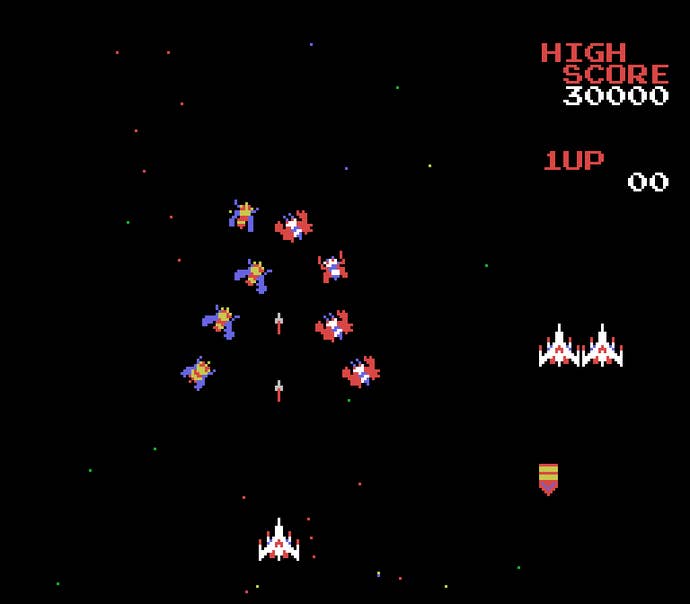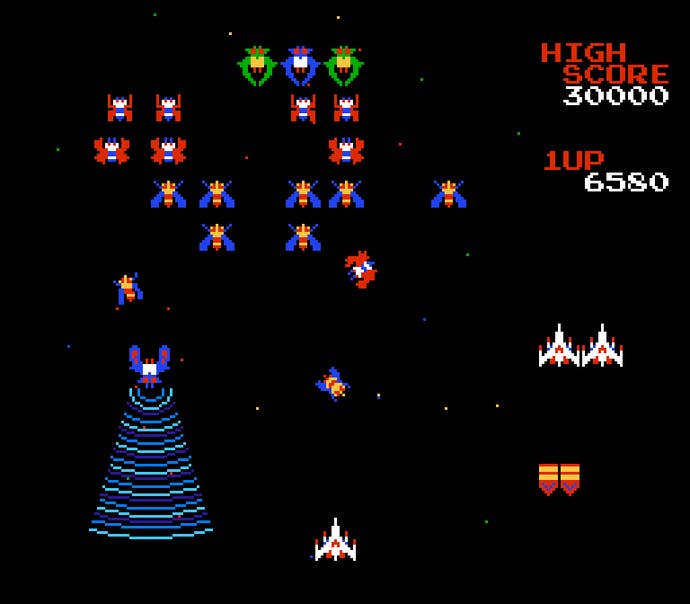Virtual Spotlight: Galaga
Sure, it's an all-time arcade classic, but is the Virtual Console version of this great worth bothering with?
This article first appeared on USgamer, a partner publication of VG247. Some content, such as this article, has been migrated to VG247 for posterity after USgamer's closure - but it has not been edited or further vetted by the VG247 team.
This week's big Virtual Console release comes in the form of Donkey Kong: Original Version for 3DS. Yes, this is the same game as the 30-cent Donkey Kong Nintendo published a month ago on Wii U. Except, of course, this release will run you $4.99 whether or not you downloaded the Wii U version thanks to Nintendo's lack of a shared account system. Isn't that great?
Did I mention that Nintendo gave away an unexpurgated version of Donkey Kong -- one with a stage this release is missing -- as a free bonus last year? No matter how you look at it, it's a bum deal. So, let's talk about something else.
As it happens, this week's other Virtual Console release (the game for Wii U) happens to be of the same vintage as Donkey Kong, and it's almost as much of a classic. Not only that, but its NES port was much less compromised than Donkey Kong's so-called "Original Version." I'm referring, of course, to Namco's Galaga, perhaps the world's greatest riff on Space Invaders... or at least the greatest until Space Invaders DX reclaimed the crown.

Galaga didn't revolutionize games the same way Donkey Kong did, but unlike Kong it remains every bit as fun to play today as it was back in 1981. Galaga took the standard pre-scrolling shooter model established by Space Invaders and shook it up with a perfect balance of hazards, risks, rewards, and strategies. On the surface, Galaga looked more or less like Galaxian with nicer graphics, but the game's depth leaps out at you after only a few minutes play.
In the traditional fashion, players control a single ship at the bottom of the screen, blasting away at alien invaders who flock (or rather, swarm -- these guys look remarkably insectile) at the top. The aliens arrive on screen in waves, line up in formation, and break away to dive-bomb the player. They follow simple patterns and routines, but once you have three or four ships zipping around doing different things, there's a lot to keep up with all at once.
What sends Galaga over the tipping point into true classic status, however, is the capture mechanic. Certain alien assailants will occasionally pause a short distance away from the player, unleash a tractor beam, and attempt to snare the player's fighter. Should you fall astray of the beam, you'll lose that ship, and it will fly around in tow behind the enemy that stole it. If you kill the captor while it's in formation, your own fighter will become an assimilated enemy and will swoop down to destroy you like any other enemy.

On the other hand, if you manage to pop the captor while it's towing your lost ship on a bombing run without destroying your lost comrade, you'll free the other fighter and recapture it, linking it alongside your active ship. This doubles your firepower in a game where double firepower really means something. Galaga predates the rise of massive power-ups in shooters, so you'll never gain the ability to fill the screen with blooms of destruction. But shooting two parallel bullets at a time instead of one? You're like a god of death.
And yet, this obvious strategic advantage comes with plenty of downsides, too. A captured ship counts against your stock of lives, and recapturing a lost fighter doesn't replenish your life tally. When it's gone, it's gone, and twin fighters represent two of your three total ships out there in action at once. Make no mistake, it's no easy task to keep twin fighters unscathed, either; you fire double-wide shots, yes, but that's because you represent a double-wide target. When the air grows thick with enemy bullets and bee warriors circling back in tight loops, keeping two ships free of danger becomes a daunting task. And once you lose a ship, you're right back to where you were.
It's a simple formula for success, but an intoxicating one.
ConclusionNamco has given us no shortage of ways to play Galaga, and every other version on the market is the slightly superior arcade one (whereas this is the NES conversion). I'd put the Wii U Virtual Console release at the bottom of my list of preferences -- but still, a good port of a great game is nothing to sneeze at. Galaga is one of those library essentials that needs to be in every collection. If you don't get this version, get <em>some</em> version.








